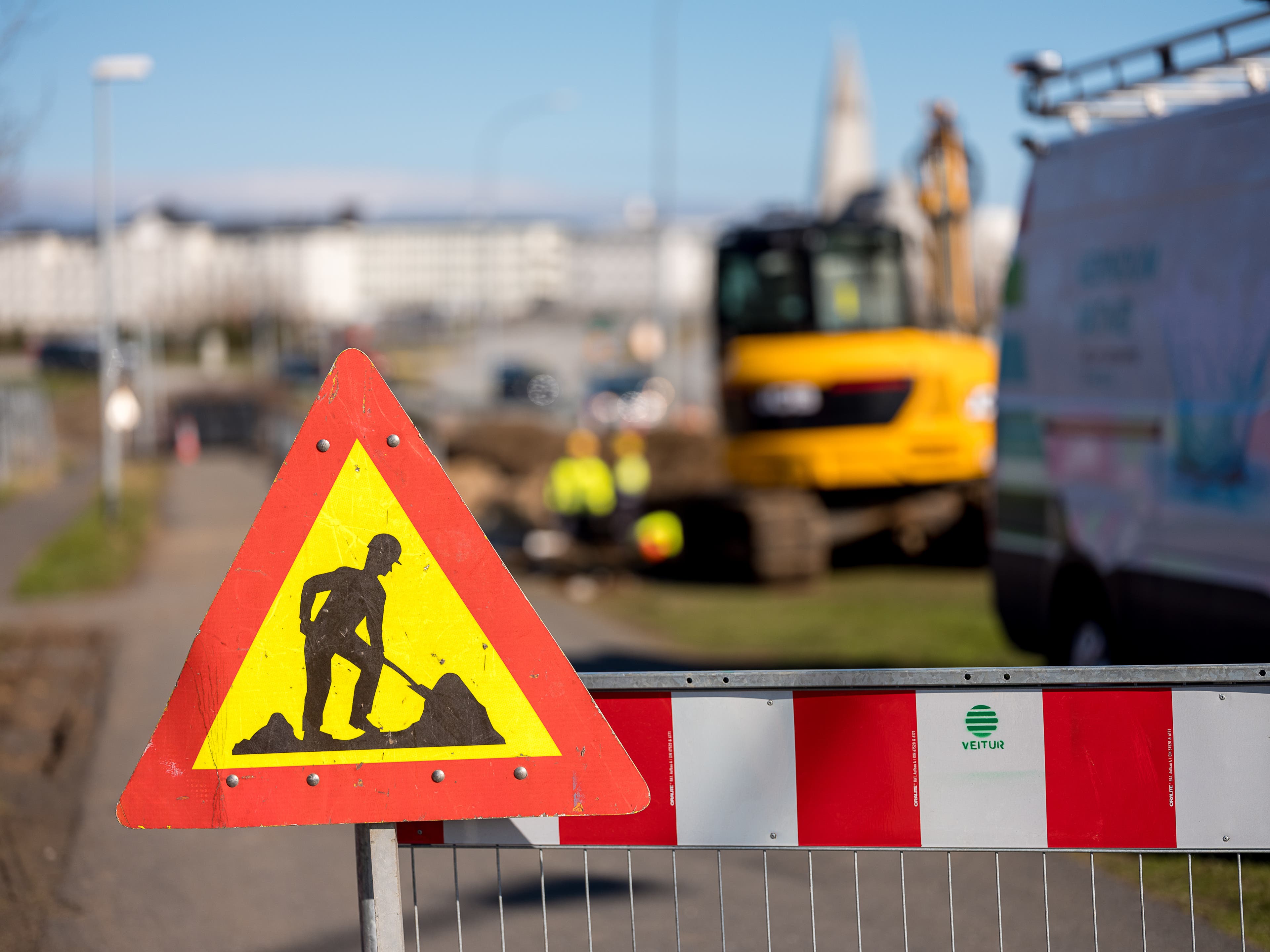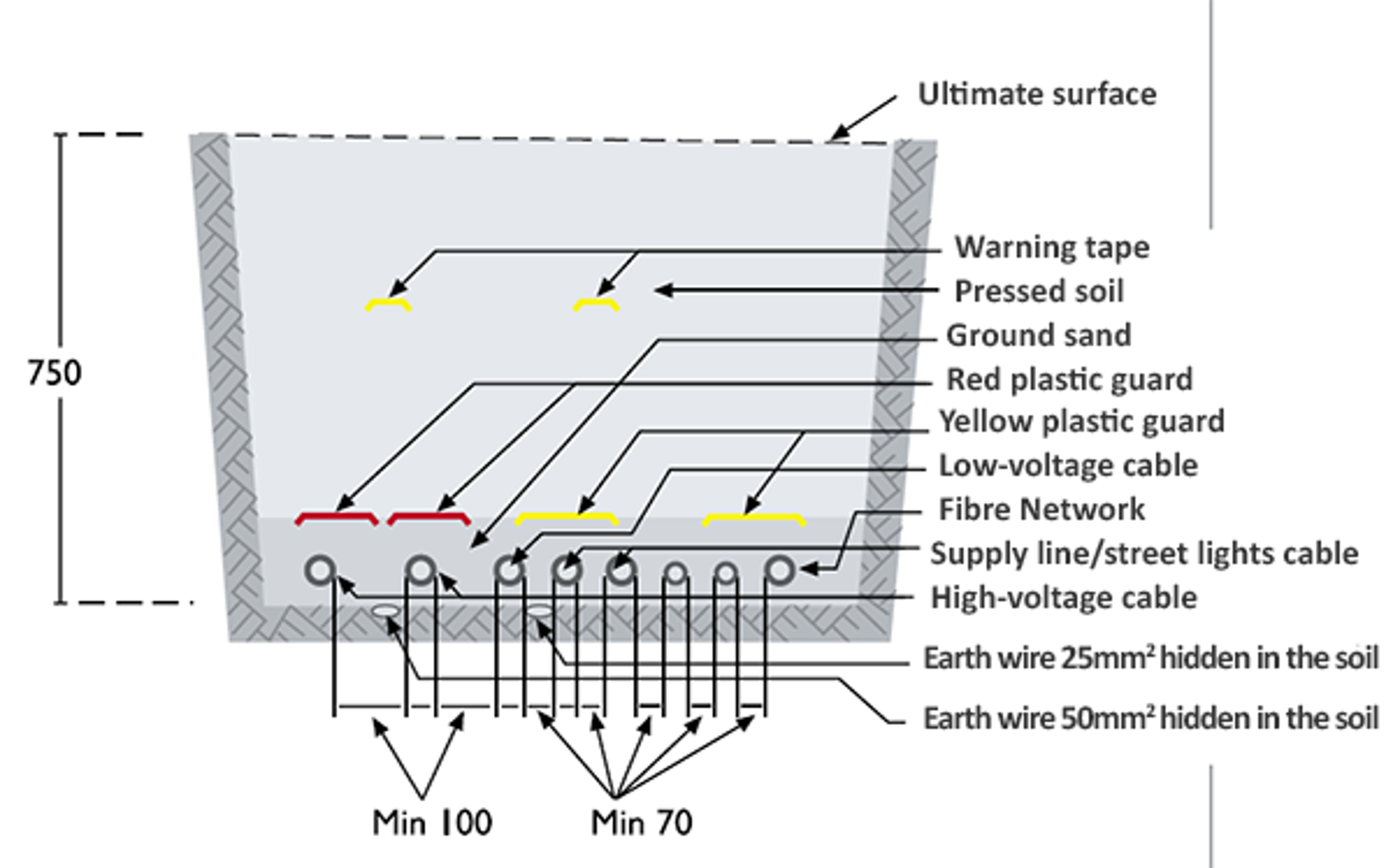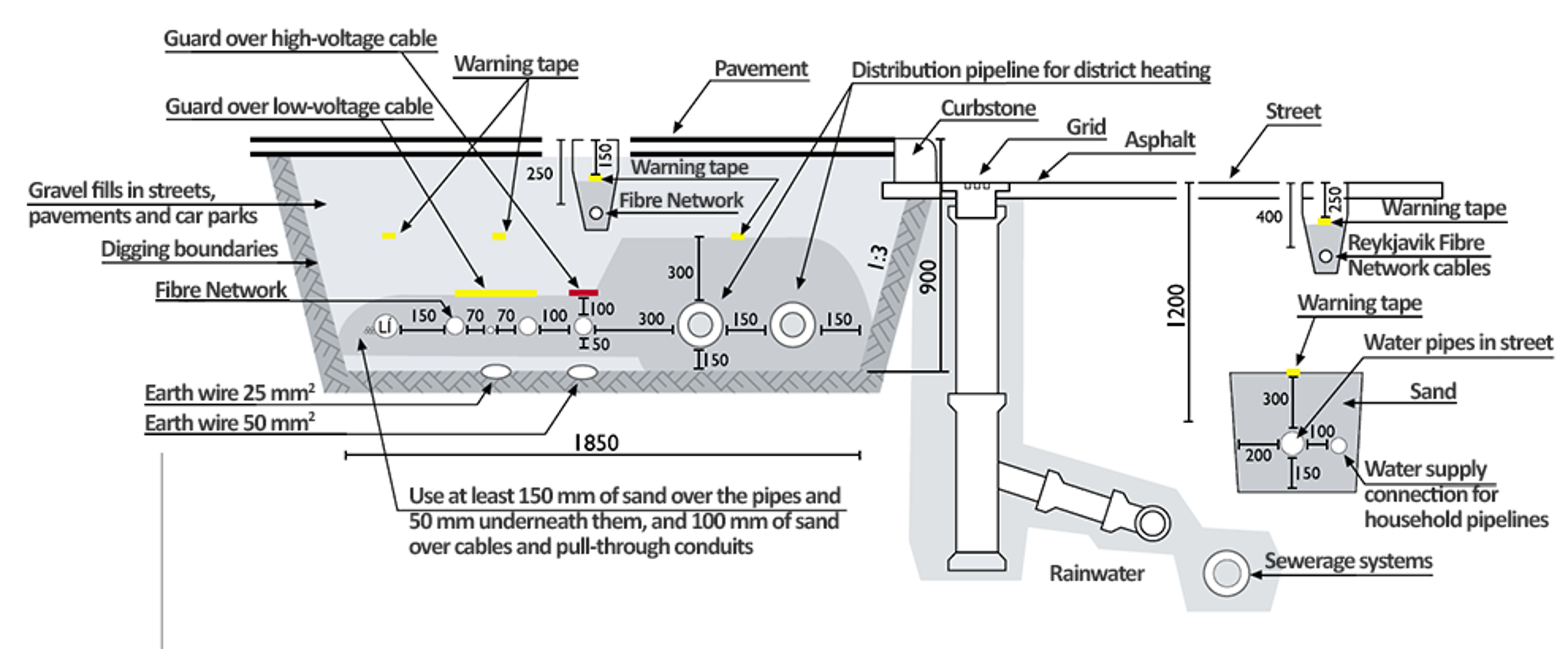Are you about to dig?
Before digging, it is essential to have a clear overview of the project and the worksite. Good preparation contributes to a safe and successful operation.

Handling of utility pipes
Veitur Utilities’ regulations regarding the treatment of utility pipes is based on long experience. The treatment has to last for decades and there are therefore many requirements. Experience in the effective handling of pipes is very good and in many places there are undamaged pipes that have been operating for more than half a century. A lot of unexpected things can happen below the surface and this is taken into account. Stones sink into the sand and the sand seeps away from the utility pipes in porous sub-layers.

Earthwork cross-sections
Most projects are conducted according to predetermined earthwork cross sections. These cross sections jointly comprise all the entities that have utility pipes in our utility areas, see an example of such a cross section above. When earthwork cross sections are stipulated in a project, they must be meticulously observed. All of Veitur Utilities’ big projects are based on these cross sections so it is very important to be able to read them. If there are any doubts regarding which cross section should be used, please contact us.
In cases where Veitur Utilities has not issued earthwork cross sections which describe the arrangement of the utility pipes, the following general rules can be applied:

Depth of pipes
The stated depth of the pipes is measured over the pipes.
- All things being equal, electrical installations and district heating pipes are laid at a depth of 70 cm. High-voltage cables, however, are mostly laid at a depth of 90 cm.
- Cold water pipes are laid at a depth of at least 120 cm, although generally no deeper than 2 m.
- All things being equal, Reykjavik Fibre Network’s cables are laid at a depth of 25-40 cm.
In some cases utility pipes are laid at a different depth, if the landscape or planning requires it.
The surfaces of streets, lots and open areas can also change and it is therefore not always possible to rely on the general rules regarding the depth of pipes or the depths stated in drawings.

Underlay
When changing the soil under pipes, use frost-resistant materials in the sub layers under them. The underlay should be levelled and compacted before the sand goes on. The underlay should be tight enough to prevent the sand from spilling below. If there is any danger of that happening, a soil blanket should be placed over the underlay to prevent it. The blanket should be broad enough to cover the bottom and sides of the layer of sand, but never narrower than 40 cm. If an earth wire (bare copper wire) is in the trench it should lie below the underlay closest to the soil.
Sanding
The right kind of sand in sufficient thickness around the pipes ensures no damage is done to their protective coating by stones or other foreign objects. The sand is also important to be able to find older pipes when digging down to them. Sometimes stones that have dropped into the trench during the levelling and other work have to be cleared out of the sand. The quality and thickness of the sand layer also have to be ensured.
Quality of sand
We require that the sand that is used must be ground sea sand or natural sand, but neither grit nor shell sand. The largest permissible size of granule is 6 mm and it shall contain no stones or sharp edges. Our inspectors shall check the quality of the sand to be used, if there are any doubts about its quality. If required, we shall research the quality of the sand in greater detail.
Thickness of sand layer
The sand requirements are stated in the earthwork cross section. Otherwise one has to aim at creating a 15 cm layer of sand under the water pipes and a 30 cm sand layer above them, whether they are hot or cold water pipes.
Around electrical installations the sand layer shall be at least 5 cm on all sides, except at least 10 cm over the cables.
If required, our inspectors can provide precise information on the sanding of thicker pipelines or high voltage electric cables.
Filling in the trenches
The trenches shall be filled with the same material as before, unless a change in material is required. Generally speaking, frost-resistant materials should be used and compressed into layers. The thickness will be determined by circumstances and the compacting equipment used. Trenches cannot be filled with shattered rocks or stones of a diameter greater than 150 mm.
Gap between electrical cables
The gaps between low-voltage cables in a trench shall be at least 7 cm and 10 cm between high-voltage cables.
Guards over cables
All of the guards that are removed from the cables must be put on again. On older pipes, hollow guards are normally fixed over each individual cable. These guards should be put back as they were. On new pipes there are normally clamps that hold up to four cables together or plastic guards that are 14-20 cm wide. Clamps and yellow plastic guards shall be placed 10 cm over low-voltage cables. Moulded clamps or red plastic guards shall be placed 10 cm over high-voltage cables. The control cable shall lie over the high-voltage cable guard.
If guards are missing we provide them.
Warning tape
Warning tapes shall lie in the filling material somewhat above the guards. Warning tapes can be obtained from Veitur Utilities. Care should be taken to remove old warning tape that no longer applies so that it does not give the wrong information to people who later dig down to them.
Evaluations
Our inspectors need to evaluate the arrangement of the utility pipes before the trenches are refilled. They have the authority to require adjustments or that a task be redone if the job was not satisfactory. It is particularly important to ensure that the manholes and fittings are secure.
The inspectors evaluate the following elements:
The sand underlay, handling of fittings, laying of utility pipes, the sand overlay, laying of guards, laying of warning tape, quality of sand and more.
Measurements
Our staff measure new, altered and previously unmeasured utility pipes and send the measurements to be registered in Veitur Utilities’ Land Information System.
Manholes
On district heating pipes the manholes are underground. When handling the soil in the vicinity of a manhole care shall be taken not to damage their air vents.
Spindles
Hot and cold water pipes often have valves with extension spindles so that they can be turned on and off without disturbing the soil. The surroundings of these spindles require careful handling and sanding so that they can fulfil their purpose when needed. Special care shall be taken to ensure that the valve on the spindle ends up in the right position on the surface.
Fire hydrants
Care needs to be taken to ensure that fire hydrants are not damaged during the handling of other utility pipes. This can have significant consequences.
When digging around a fire hydrant, you should obtain information or assistance from Veitur Utilities’ staff on how best to handle it. If assistance is needed, you can request it by phoning: 6176482 or 6177290.
Fibre optics cables
The Reykjavik Fibre Network lays cables in Reykjavik and many other places. Reykjavik Fibre Network cables are laid with new utility pipes but in older neighbourhoods, their network cables are laid in special shallow trenches on suitable pipeline paths. Pull-through conduits are laid between potholes and in houses and the fibre optic cables are pulled through the conduits. From the property boundaries and into the house the Reykjavik Fibre Network cables follow the pipeline paths for hot and cold water, electricity and phone lines.
All household pipelines in one trench
Veitur Utilities lays all household pipelines in one trench from the property boundaries to the foundations of the house if that is possible. When laying the mains system of the utility pipes, we work from the utility pipes by the property boundaries and a cable hank is left behind which must be sanded before it is covered with soil. A wooden stake (cross) or cable guard should be placed there to mark the location of the cable hank.
A module for the household pipelines is moulded in the foundations or base of the building.
Supply station
Countless pipelines branch out from Veitur Utilities’ supply stations since they are crucial links in the electricity distribution system. Damage close to supply stations can have major consequences since many electricity users are connected to each station.
Street lights
We take care of running the street lighting system for municipalities, the Icelandic Road and Coastal Administration (IRCA), companies and individuals. Thin electric cables lie between street lampposts. We should be notified of any damage to street lamps. We also manage the dismantling and setting up of lampposts in construction areas.
In setting up street lampposts both cables should enter the same hole in the lamppost. Cable hanks are also left behind to reduce damage and facilitate repairs.
Link boxes
One of the most visible items in the electricity distribution system are link boxes. Many cables branch out from these and Veitur Utilities needs to know of any disruptions around them.
Distribution centres
In recent times Veitur Utilities has set up fewer distribution stations than before. Stations are less obvious in their environment but the risks are the same as before when earthwork is conducted in their vicinity.
Pumping stations
In our utility areas there are widespread boreholes for hot water with pumping stations. The district heating distribution system branches out in their vicinity.
Shut-off valves
In the distribution system for hot and cold water there are shut-off valves to limit damage and facilitate repairs. When working on the surface over the shut-off valves, care must be taken to ensure they are standing above the surface and that they are not stuck.
District heating manholes
District heating manholes have air vents, which are important for the ending of the pipes in the holes. Any damage to the air vents must be reported to Veitur Utilities.